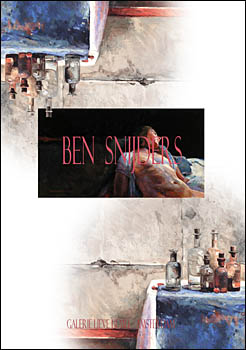
Under the Spell of Painting

This catalogue has been published at the occasion of Ben Snijders' solo exhibition, September 22 - October 21 2018, and is compiled and written by Koen Nieuwendijk. (16 pages, 27 full colour reproductions, ISBN 978-90-70402-54-9)
My close collaboration with Ben Snijders (b. 1943) goes all the way back to 1978. Enamoured as I originally was with his painstakingly detailed miniatures, I soon realised that this was a painter who ate, slept and breathed oils. His work has taught me that abstraction and realism do not necessarily belong to separate worlds, by getting me to appreciate that these designations reflect the tool more than they do the style and that the disparity between minute detail and sweeping brush strokes defies being classified under the heading of no matter which qualitative standard. I have to confess that I was pretty gung-ho in those early days, considering precision of detail as my be-all and end-all while summarily dismissing the more impressionist techniques and, worse still, giving free rein to my reluctance for abstraction. The subsequent broadening of vision catalysed by my acquainting myself with Snijders’s work left me with a sense of relief I had not seen coming.
Not long ago I was reading a fascinating article about the development of photonic chips. These run on light particles rather than electrons, thus enabling the speed of digital communication to be enhanced (NRC, 11 August 2018). I suppose this is where I should confide in you about my penchant for steeping scientific novelties in a romantic haze, which in this particular case made me hopeful of having chanced upon the missing link between the artistic ability to captivate people using painted light on the one hand and the process of people experiencing light as such on the other, as this might enable me to explain how Ben Snijders transforms his passion for oils and turps into a tableau, which our eyes in turn help us translate into feelings. I seem to be one link short, however, or rather, I could do with an entire bucket-load, which sadly stops me explaining that a still life and a nude are closely related, that a landscape is considerably less different from an array of bottles and jars perched on a shelf than you might think, and that classifications such as these are for appearances’ sake only.
From which it does not necessarily follow, I should add, that I choose to conform to the target of choice of the “knights in shining armour” within the artistic community as embodied in the mantra of social relevance, one of whose recurrent hallmarks is parochialism. Not that I have anything against social relevance, but I cannot help thinking at the same time that platitudes and labels constitute the footings of a well-oiled society. Perish the thought that you and I and all those who know better would no longer be able to rely on an orderly classification of the chaos that is the natural product of the human mind! The fierce brainstorm that followed convinced me that I had figured out how to justify that Snijders in a genuine manner has commandeered the organisation of chaos in his paintings, all the while relying on traditional tools in positioning himself as a champion of the cause of tried and trusted avenues. You read what I write and understand what it is I’m trying to bring across, and yet there’s no way I can prove it. But I digress.
Ben Snijders’s life as a painter is the sum total of decades of meandering between nature morte and nude, between the sweeping gesture and the poise without which there can be no detail. One thing that never ceases to enthral is Snijders’s ability to combine all these qualities in a single painting – depending, that is, on the outcome of the tug-of-war inside him: should he add more detail, or should he round off, sign and move on?
Be this as it may, it is heart-warming to know that it still exists: the purest pleasure in painting, the lavishness of gloopy brush strokes, of concentration materialised in detail, all taut and accurate … and that’s not even mentioning everything else that is possible, is permissible, and may occasionally even come across as preconditional, darn it. Born in 1943, Ben Snijders is a veteran master of his trade and one of those to whom the Minerva Art Academy in Groningen for dozens of years owed its reputation as a breeding ground for realistic talent. A painter who like a modern-day alchemist transforms a collection of inconspicuous vials and flasks, dried-up leaves and withered flowers, dust and a handful of cherry stalks into a feast of oil paints, of light, colour, texture and, wait for it, abstract values, into a form of painting which must not be allowed ever to be lost. Unique in this respect Snijders may not quite be, but one thing is beyond doubt: nobody does it better than he does, which makes his stellar individual class invaluable to the art historical perspective.
|
|